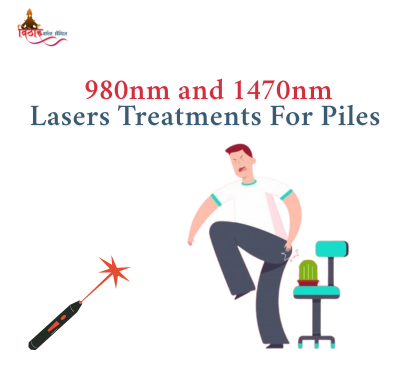Laser treatments are revolutionizing the management of anorectal diseases such as hemorrhoids, fissures, and fistulas in India. Specifically, the 980nm and 1470nm diode lasers have emerged as preferred technologies for proctology due to their minimally invasive nature, precise targeting, and significantly improved recovery profiles compared to traditional open surgeries. This article explores why these laser wavelengths have become the gold standard for many surgeons, explains their underlying science, and guides patients about what to expect from laser-based interventions.
Understanding Laser Technology in Proctology
Lasers are focused beams of light that can be tuned to specific wavelengths. In medical practice, the choice of wavelength determines how effectively the tissue absorbs the energy and how precisely a surgeon can treat the affected area. For anorectal conditions:
- 980nm diode laser: This wavelength is particularly effective at coagulating blood vessels and shrinking abnormal tissue, making it well-suited for hemorrhoid and fissure treatment.
- 1470nm diode laser: Absorbed more efficiently by water in tissues, this wavelength results in even less thermal spread, enabling very targeted treatment with minimal collateral injury—ideal for delicate procedures such as fistula closure.
Conditions Treated with Laser
- Hemorrhoids (Piles): Swollen veins in the rectal area causing pain, bleeding, itching, and sometimes prolapse.
- Anal Fissures: Small tears in the anal lining causing sharp pain and bleeding during bowel movements.
- Fistulas: Abnormal tunnels between the anal canal and skin, often resulting from previous infections.
Laser techniques are applicable for multiple grades of hemorrhoids, both chronic and acute fissures, and a wide range of fistula anatomies.
How Do 980nm & 1470nm Lasers Work?
The laser probe is introduced into or just under the affected tissue, emitting focused energy that:
- Shrinks piles by coagulating blood vessels and reducing nodules from within.
- Seals nerve endings, which leads to less postoperative pain.
- Removes abnormal tissue precisely with minimal impact on healthy regions.
- Reduces risk of recurrence when appropriate wavelength, energy, and technique are used.
Key Clinical Advantages
1. Minimally Invasive
No large open incisions are made. Instead, surgeons use fine laser probes, resulting in:
- Less tissue trauma
- Minimal bleeding
- Smaller wounds and scars
2. Precision and Safety
Both lasers allow accurate targeting of diseased tissue, protecting healthy adjacent structures. This reduces:
- Unnecessary damage
- Postoperative complications
- Risks of infection and delayed healing
3. Reduced Pain & Faster Recovery
Laser energy seals nerve endings and blood vessels in real time, making post-treatment pain and bleeding dramatically less compared to traditional surgery. Most patients can return home the same day and have a shorter overall recovery period.
4. Lower Risk of Recurrence (With Proper Technique)
When performed with optimal energy settings and technique, recurrence rates with 980nm are comparable to open surgery, while some evidence suggests that inadequate technique with 1470nm may increase recurrence—but with proper protocols, outcomes remain highly favorable.
980nm vs. 1470nm: Scientific Comparison
| Attribute | 980nm Laser Treatment | 1470nm Laser Treatment |
| Absorption | Well-absorbed by blood | Best absorbed by tissue water |
| Target Area | Vascular tissue (hemorrhoids) | Soft tissue (fistulas) |
| Effect | Coagulation, shrinkage | Precise ablation, less spread |
| Recurrence | Comparable to open surgery | May vary, needs optimized use |
| Safety | High, low thermal injury | Highest, least collateral risk |
Each wavelength has its optimum application depending on the nature and depth of the tissue. Most Indian proctology centers now offer treatments using both wavelengths depending on specific patient needs.
Common Procedure Steps (Laser for Hemorrhoids)
- Local or spinal anesthesia is given.
- The laser probe is inserted into the symptomatic pile(s).
- Controlled energy shots are delivered, causing shrinkage and sealing.
- No major cutting, suturing, or removal of large tissue pads.
Results and Outcomes in India
Studies across Indian hospitals indicate:
- Minimal postoperative pain and discomfort.
- Short operation times (often 20–30 minutes).
- Day-care procedure—patients usually discharged within hours.
- Low risk of serious complications.
- Faster return to work or daily routine, critical for working professionals and elderly patients.
Who Should Consider Laser Treatment?
- Grade II/III internal hemorrhoids resistant to lifestyle management.
- Patients having repeated fissure episodes or chronic non-healing fissures.
- Individuals with fistula-in-ano, especially complex or recurrent cases.
- Those seeking rapid recovery with minimal pain or downtime.
When Is Open Surgery Still Required?
Laser is not recommended for very large, fibrotic, or externalized piles (Grade IV), or when there is extensive tissue involvement. Open or stapled surgery remains important for advanced disease, and a specialist should guide the choice.
Safety, Precautions, and Risks
Although laser treatment is generally safer than open surgery, risks include:
- Temporary bleeding or mild discomfort.
- Rare infection or incomplete healing.
- Recurrence if underlying pathology is not fully addressed (particularly technique-sensitive in case of 1470nm laser).
Consultation with an experienced proctologist and selection of the right laser settings mitigate risks and offer best results.
FAQ
- Is laser piles surgery painful?
The pain is minimal—laser seals nerve endings and blood vessels, significantly reducing pain compared to traditional open surgery. Most patients experience only mild discomfort after the procedure. - How soon can one return to normal life after laser treatment?
Most people resume working or daily activities within a day or two of surgery, due to minimal wounds and shortened recovery periods. - Is recurrence common after laser treatment for hemorrhoids or fistulas?
Recurrence depends on disease grade, surgeon experience, and technique. For 980nm laser, recurrence rates are comparable to open surgery. For 1470nm, recurrence can be higher if technical parameters are not optimized. Modern protocols offer highly reliable outcomes for most patients.

